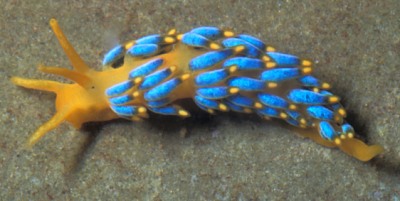
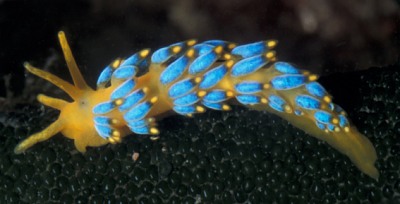
Cuthona speciosa
(Macnae, 1954)
Order: NUDIBRANCHIA
Suborder: AEOLIDINA
Family: Tergipedidae
DISTRIBUTION
South Africa
PHOTO
In the deeper intertidal pools (50cm deep) at Marsh Strand, near Haga-Haga, Eastern Cape, South Africa. L: 9 mm. Photos: Lindsay Warren.
Body, rhinophores and oral tentacles all translucent yellow orange, sometimes with pinkish speckling on the head tentacles. The digestive gland duct is a dark greenish colour but this is obscured by the colour of the ceratal wall which is usually a bright milky blue. The tip of each ceras is usually bright yellow and there is a gap between the yellow cap and the blue region through which the dark greenish digestive gland is visible. Gosliner & Griffiths (1981) report a lilac colour form in which the ceratal wall is lilac, rather than blue, and the ceratal tip is white rather than yellow. They note that it feeds on the calyptoblastic hydroid Sertularella. According to Gosliner, (1987), it has only been found in the south of South Africa, from Oudekraal on the Atlantic coast of the Cape Peninsula to Port Elizabeth.
References:
• Gosliner, T.M. & Griffiths, R.J. (1981) Description and revision of some South African aeolidacean Nudibranchia (Mollusca, Gastropoda). Annals of the South African Museum, 84(2): 105-150.
• Gosliner, T.M. (1987) Nudibranchs of Southern Africa, a guide to the Opisthobranchs of southern Africa. Sea Challengers, Monterey. 136pp.
• Macnae, W. (1954) On some eolidiacean nudibranchiate molluscs from South Africa. Annals of the Natal Museum, 13: 1-50.
Rudman, W.B., 2002 (July 24) Cuthona speciosa (Macnae, 1954) . [In] Sea Slug Forum. Australian Museum, Sydney. Available from http://www.seaslugforum.net/find/cuthspec
Related messages
Cuthona speciosa? from False Bay, Sth Africa
June 11, 2007
From: Georgina Jones
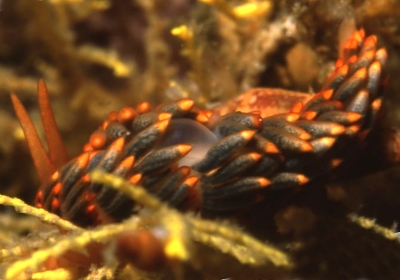
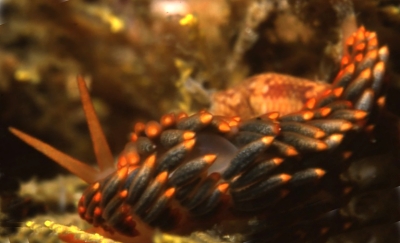
Dear Bill
I saw three of these little guys on a deep wreck in Smitswinkel bay on Saturday .. the photos aren't great, but do you think they could be Moridilla brockii? It will be a significant range extension if yes though, because the reference books say so far they've only been found off South Africa at Sodwana Bay which is on our east coast.
Locality: Smitswinkel Bay, 28m, Western Cape, South Africa, False Bay, 19 May 2007, hydroid encrusted wreck bollard. Length: 10-12mm. Photographer: georgina jones.
best regards
Georgina
gjones@icon.co.za
Jones, G.J., 2007 (Jun 11) Cuthona speciosa? from False Bay, Sth Africa. [Message in] Sea Slug Forum. Australian Museum, Sydney. Available from http://www.seaslugforum.net/find/19962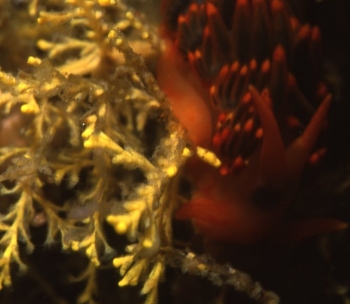
Dear Georgina,
Although quite similar in colour, this can't be Moridilla brockii because that species has papillae on the rhinophores and in your animal the rhinophores are smooth and tapering.
I may be wrong but my guess is that it is Cuthona speciosa. I haven't heard of one with such dark grey cerata, but we don't seem to have much information on colour variation at present.
Best wishes,
Bill Rudman
Cuthona speciosa from South Africa
July 26, 2002
From: Lindsay Warren


Dear Bill,
Just thought you might like these shots of Cuthona speciosa (Macnae, 1954) for the Sea Slug Forum since there doesn't appear to be a posting for it yet.
This specimen was found at a depth of 50cm by Kevin Reed on 15 February 2002 in the early afternoon while snorkelling in the deeper intertidal pools at Marsh Strand, near Haga-Haga, Eastern Cape. L: 9 mm.
Photos: Lindsay Warren.
On looking at the rhinophores they appear to be hollow 'tubes' - is this an optical illusion or are they in fact 'tubes'? According to Gosliner, (1987), it is endemic to South Africa.
All the best
Lindsay
alldcl@compuserve.com
Warren, L., 2002 (Jul 26) Cuthona speciosa from South Africa. [Message in] Sea Slug Forum. Australian Museum, Sydney. Available from http://www.seaslugforum.net/find/7630Thanks Lindsay,
Yes this does appear to be a South African endemic. Concerning the apparently tubular rhinophores - as far as I know it is an optical illusion. Neither C. speciosa, not any other aeolid has been been reported to have hollow, tubular rhinophores.
Best wishes,
Bill Rudman
